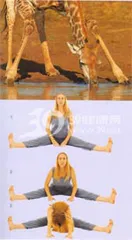Yoga Posture: Japanese Prayer
Reminder of this station:
The physical and mental condition of women during pregnancy is in an extraordinary period. Therefore, based on safety policy considerations, it is strongly recommended that you, regardless of whether you have practiced yoga before or whether you are practicing it for the first time, pregnant women must listen to the advice of a practicing doctor and obtain permission before practicing yoga before it is too late. We believe that medical practitioners 'suggestions and advice on pregnant women's mental and physical diseases and physiological and psychological factors that are not suitable for practicing yoga have unquestionable authority.
Practice: Stand upright in the position of the

, with your feet closed, and the inner thigh muscles contracted together. Place your hands on your chest in a prayer gesture, take a preliminary breath, inhale and then exhale (Figure 1).
Tighten your hip muscles (this protects your lower back). Inhale, straighten your arms forward and lift them over your head, closing your hands and facing each other (Figure 2).
Exhale, bend into an upright forward bend position, relax your neck, head down, and if necessary, bend your knees slightly to reduce pressure on the back of your legs (Figure 3).
Inhale, bend your left knee, extend your right leg backward, place your right knee on the ground (this reduces pressure on your lower spine), look up, and stretch your body (Figure 4).
Exhale, stretch your left leg backward, and your left foot is close to your right foot. In this action, only the hand and foot touch the ground, and the arm must be straightened. Keep your hips contracted and your spine straight to protect your lower back. This position is called a wooden plank. Then, inhale (Figure 5).
Exhale, bend your knees and place them on the ground, arch your hips back, and put your chest and forehead to the ground.
This posture is called worm pose. Due to the enlarged abdomen in the third stage of pregnancy, this posture does not need to be practiced (practicing worm pose usually requires holding your breath, but because it is not advisable for pregnant women to hold their breath, breathing exercises are added to this process, Figure 6). Inhale in

the, move your hips forward, put your hips on the ground to form a Cobra pose, raise your head and chest, bend your elbows close to the chest area, relax your shoulders, and look up (you don't need to practice this position in the final stages of pregnancy, Figure 7).
Exhale, roll your feet back, straighten your arms, lift your hips and tail vertebrae upward to form a top-down dog stretch. Do not move your hands and feet, just straighten your arms and knees, relax your neck, and put your heels to the ground (Figure 8).
Inhale, bend your right foot forward and place it between your hands, put your left knee on the ground, stretch your body, and look up (Figure 9).
Exhale, take a step forward with your left foot, level with your right foot, and return to the upright and forward flexion position. If necessary, bend your knees to avoid undue pressure on the dorsal fossa or legs (Figure 10).
Inhale, straighten your arms forward and lift them over your head, palms facing each other, and hands together (Figure 11).
Finally, exhale, stand upright, and place your hands on your chest in prayer (Figure 12).
Return to normal breathing and repeat the routine. This time, when you reach step 4, straighten your left foot back and bend it forward again at step 9 to form a complete round. After being proficient, you may not be panting after practicing for 10 rounds.
Relative posture: Stand upright with your feet about 30 centimeters apart, then bend forward at will until your heartbeat and breathing return to normal. After practice, you can lie flat on your back and relax (also known as lying on your back). Continue for at least 5 minutes and take deep breaths to relax. These are the most basic relaxation methods.
Benefits:
This series of movements is one of the most important poses in yoga. It exercises muscles in all parts of the body, improves cardiovascular disease and adjusts the correct breathing rhythm. If you don't have time to practice the full yoga routine, you can practice 5 to 6 rounds of Japanese salutations with soft music, then adjust your breathing and relax.
Notes:
As your abdomen grows, you can practice with your feet apart. Posture 6 (Worm) and Posture 7 (Cobra) can also be omitted. In other words. You can go directly from Posture 5 (plank pose) to Posture 8 (down-facing dog stretch). This exercise should be carried out in conjunction with the victory breathing, otherwise you will feel unable to breathe. (Internship Editor: Long Weiquan)